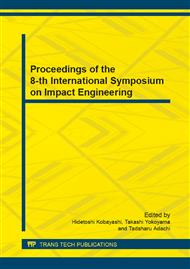p.167
p.173
p.179
p.185
p.193
p.199
p.205
p.211
p.219
Behaviour and Design of Steel Columns Subjected to Vehicle Impact
Abstract:
The main objective of this study is to develop a simplified analytical approach to predict the critical velocity of vehicle impact on steel columns. This method utilizes the energy balance principle with a quasi-static approximation of the steel column response. Results of ABAQUS numerical simulations of the dynamic impact response of axially loaded steel columns under vehicle impact are used to validate the proposed method. To account for the effect of vehicle impact, a simplified numerical vehicle model has been adopted using a spring-mass system with a bilinear spring load-deformation relationship. The validation results show good agreement between the analytical method results and the numerical results with the analytical results tending to be on the safe side.
Info:
Periodical:
Pages:
193-198
Citation:
Online since:
June 2014
Authors:
Price:
Сopyright:
© 2014 Trans Tech Publications Ltd. All Rights Reserved
Share:
Citation:


